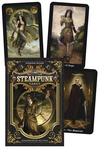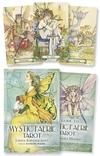Revitalizing Your Tarot Practice, Part I: Decks

Imagine this: you shuffle your beloved cards, lay them out, stare at them, and suddenly see…nothing! Or worse, you don't even feel like picking up your deck. Or perhaps you lay out the cards and you feel uninspired and bored. The cards don't seem like familiar friends full of wise council; instead, they feel like a rerun of Seinfeld that you've seen sixteen times. These are all signs of what some people call "Tarot Reader Burnout."
Tarot Reader Burnout happens to most tarotists at some time or another. Just as a friendship or relationship can become dull and stagnant, your reading practice or study can become routine. Luckily, just as there are plenty of tips and tricks to revitalize a relationship, there are lots of ways to reinvigorate your tarot practice. In this article, we'll look at using decks as a way to renew your readings. In part II, we'll cover a variety of techniques that can be used with your tried and true deck (or a new one, if you really want to shake things up!).
Many readers use the same deck or decks. That makes sense, because once you are comfortable with a deck, it is easier to be more confident in your readings. Knowing all the nooks and crannies of an image and all (or apparently all) its layers of meanings allows you to more efficiently process the cards in the spread and synthesize them into a coherent message. With that benefit comes a downside—once you feel you know a card that well, you will look at it to note what card it is, but you don't really see it. By not really seeing a card, you miss an important source of information—intuition. If your meanings or understanding of a card become almost rote, there is usually no room for inspiration. If you suspect that you might not be seeing your cards anymore, here are some ideas regarding decks that can open new windows to look through.
A Different Lens
If you use a Rider-Waite-Smith (RWS) based deck, try a different RWS based deck. Seeing images similar in composition but done in a different artistic style and with a different theme or focus make the cards interesting in way that maintains the structure you are used to and within your comfort zone. This works well for visual people who really find meaning in the images beyond the standard meanings. For those who are less visual or who always refer to the RWS images in their head (often called your mental deck), something more extreme will be better.
Something Completely Different
Break out of your RWS rut by trying a deck based on a completely different system. This may be jarring at first, as you may be tempted to say "but that's NOT what the Four of Wands means!" (If the RWS—or Thoth or whatever system you use—is the only tarot for you, then this may not work for you. That's fine—the next tip or the ones in the Techniques section in Part II might be more helpful.) Try relaxing into it and letting go of your preconceptions. Think of it as exploring a new world or culture. It's different from what you are used to, but that's part of the draw. In the end, you may decide that culture or, in this case, system, isn't for you as a whole, but just as travel changes us, visiting a new system will add to who we are as a reader. If you really dislike the experience, then if nothing else, it'll make you pick up your old deck with affection and appreciation.
Mix It Up
The beautiful and beguiling thing about cards is that they are meant to be shuffled. Mixing them up and seeing what happens is exciting. The moment before we flip the cards over, our breath catches in our throat. Well, if just mixing them up isn't working for you, try really mixing it up.
If you have two decks of the same size, pick some cards from one deck and ones from another, shuffle them together, and use them as if they were one deck. I'd suggest using parts of each, such as the Majors and court cards from one and the pips from the other, or some similar division. If you want to try this with two decks of different sizes, I'm sure it can be done with a little clever shuffling.
Do readings using two different decks (not mixed together). If you are doing a reading about two choices or about a relationship, you can use one deck for each choice or person in the relationship within the same reading. If you are doing a situation/outcome reading, you can use one deck for the positions describing and analyzing the situation and the other deck for the positions regarding the outcome and actions. In a Celtic Cross you might try one deck for the cross and one for the vertical line on the side.
One of my favorite methods is the comparative approach. Use a deck to do a reading as usual. After the cards are laid out, use a different deck, select the same cards as already laid out and set them next to the cards from the first deck. As you interpret the cards, read the two same cards from the different decks together as a kind of dialogue. I like to use one deck that is to me very light and one that is a bit darker (in imagery, not necessarily in coloring) and read them as the light and shadow side of each position.
You can add things other than other tarot decks to your readings. Oracle decks often make a great addition, especially if you find one that visually and thematically compliments your reading deck. Incorporate the oracle cards as described in the two previous tips. Or, here's a technique I like: lay your spread as usual with your tarot cards, and then put an oracle card on the right and on the left, to represent the energy leaving (left) and entering (right) the situation in question. Another option is to place one on the top and bottom of the spread to show what energy is being used to good effect (top) and what energy is being neglected or not being used to good effect (bottom). And one wonderful reader, Geraldine Amaral, always likes to pull an oracle card at the end of a tarot reading as a special closing message.

About Barbara Moore
Related Products



is subject to certain Terms and Conditions